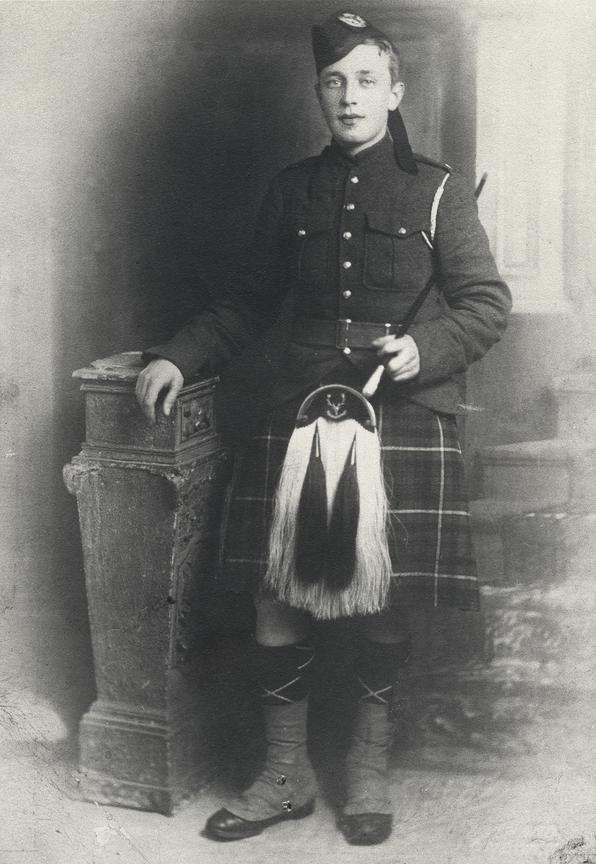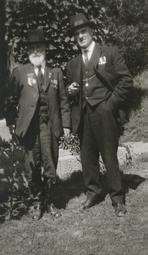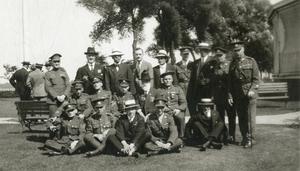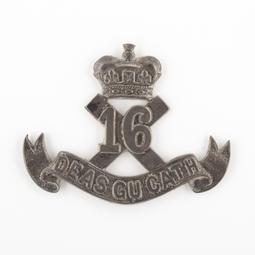Unit
16th Canadian Infantry Battalion (Canadian Scottish)
Branch
Infantry
Service Component
Canadian Expeditionary Force
Service Number
28930
birth
1897/11/25
Bellshill, Lanarkshire, United Kingdom, Scotland
death
1916/10/09
France
grave
Adanac Military Cemetery, Albert, France
Gender
Male
Private (Piper) James Cleland Richardson was born in Bellshill, North Lanarkshire, Scotland on 25 November 1895. He was the oldest son and second of eight children born to David Richardson, a police inspector, and Mary Dall (Prosser) Richardson. He immigrated to Canada in 1913, arriving in Halifax aboard the SS Parisian with his father and two of his siblings on 23 May. His mother and four other siblings joined them in Canada in October 1913 and the family settled in Chilliwack, British Columbia, where his father served as chief of police. Prior to the outbreak of the First World War, he apprenticed as an electrician and was an active member of the Canadian Militia, serving with the cadet corps of the 72nd Regiment Seaforth Highlanders.
Richardson enlisted in the 16th Canadian Infantry Battalion at Valcartier on 23 September 1914. He embarked from Quebec City with his unit aboard the SS Andania as part of the First Canadian Contingent, arriving in England on 14 October 1914. He and the 16th Battalion arrived in France on 7 February 1915.
More than a year and a half later, the 16th Battalion, with Richardson still among its ranks, was engaged with enemy forces at the Battle of Ancre Heights, a part of the larger Battle of the Somme. On 8 October 1916, the battalion was trying to advance on Regina Trench but was held up by intense gunfire and strong barbed wire that inflicted heavy casualties and demoralized the troops. Richardson, who had obtained permission to play the men ‘over the top’ prior to the battle, went outside the wire and played his pipes up and down the line, inspiring the men to continue their advance and eventually capture their objective. Later in the day, while tasked with taking a wounded man and several prisoners back to the rear, he realized that he had left his pipes behind on the battlefield. Despite warnings not to do so, he went to retrieve them. He was never seen or heard from again. He was initially reported from base as ‘wounded and missing,’ which was later reclassified on 24 July 1917 to ‘for official purposes presumed to have died on or since’ 8 August 1916. Richardson’s body, which was initially thought lost, was discovered and exhumed from a battlefield grave north of Le Sars, France on 11 June 1920 and re-interred in Adanac Military Cemetery near Miraumont, France. On 29 November 1920, his service record was officially changed to ‘killed in action’ on 9 October 1916. He is commemorated on page 150 of the First World War Book of Remembrance.
Richardson was posthumously awarded the Victoria Cross for his actions of 8 October 1916 during the Battle of Ancre Heights. His Victoria Cross was presented to his parents by the Lieutenant Governor of British Columbia, Francis Stillman Barnard, during a ceremony in Victoria in April 1919.
Ninety years after Richardson’s death, his pipes were repatriated to Canada by the British Columbia Legislature on 8 November 2006. The pipes had been found on the battlefield at Courcelette, France in 1917 by Reverend Major Edward Yeld Bate, a British Army chaplain. When Bate retired from his teaching position at the Ardvreck School in Perthshire, Scotland in 1931, he gifted his battlefield souvenir to the school and the pipes were placed on display with a card noting their 1917 discovery. In 2003, a pipe major with the Canadian Scottish Regiment travelled to Scotland and confirmed reports that the pipes on display at the school belonged to Richardson. The pipes were purchased from the school and later donated to the province of British Columbia, where they are on permanent display in the main foyer of the Legislative Assembly of British Columbia in Victoria.
Victoria Cross
“For most conspicuous bravery and devotion to duty when, prior to attack, he obtained permission from his Commanding Officer to play his company ‘over the top.’ As the company approached the objective, it was held up by very strong wire and came under intense fire, which caused heavy casualties and demoralised the formation for the moment. Realising the situation, Piper Richardson strode up and down outside the wire, playing his pipes with the greatest coolness. The effect was instantaneous. Inspired by his splendid example, the company rushed the wire with such fury and determination that the obstacle was overcome and the position captured. Later, after participating in bombing operations, he was detailed to take back a wounded comrade and prisoners. After proceeding about 200 yards, Piper Richardson remembered that he had left his pipes behind. Although strongly urged not to do so, he insisted on returning to recover his pipes. He has never been seen since, and death has been presumed accordingly owing to the lapse of time.”
- London Gazette, 22 October 1918, Supplement 30967






